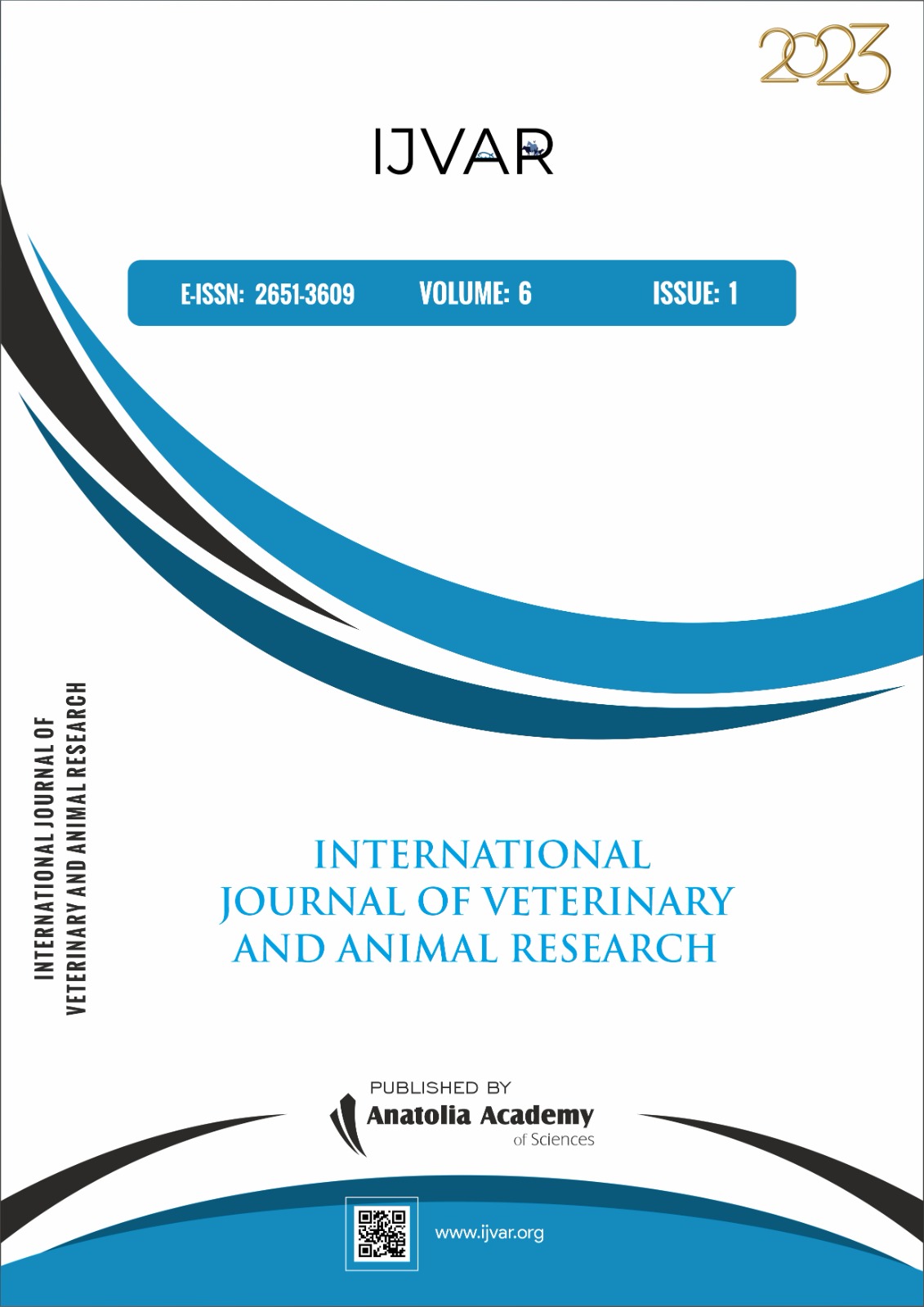Evaluation of the Effects of Medetomidine and Dexmedetomidine Use on Intraocular Pressure in Cats
Keywords:
Anaesthesia, Cat, Intraocular pressure, tonometryAbstract
In the present study, it was aimed to investigate the effects of α-2 agonists used for sedation in cats, namely medetomidine hydrochloride and dexmedetomidine, on intraocular pressure. Two study groups, each containing 17 animals, were formed. One of the groups was treated with 80 µg/kg medetomidine hydrochloride, and the other group with 40 µg/kg dexmedetomidine, via IM route. The animals underwent intraocular pressure measurement before sedative agent administration (T), at the time of vomiting (T1), after vomiting (T2), at 40th minute (T3), at 60th minute (T4), and 20 minutes after atipamezol administration (T5). There was no significant difference between intra-group intraocular pressure measurements taken at different times and inter-group IOP mesaurements taken at the same time points (P>0.05). A numerical increase occurred in intraocular pressure after vomiting, and intraocular pressure was found to be lower during sedation than at the baseline. In conclusion, it was determined that the administration of medetomidine hydrochloride and dexmedetomidine via intramuscular route for sedation reduced intraocular pressure but the levels remained within reference range.
References
Aghababaei A, Ronagh A, Mosallanejad B, Baniadam A. 2021. Effects of medetomidine, dexmedetomidine and their combination with acepromazine on the intraocular pressure (IOP), tear secretion and pupil diameter in dogs. Vet Med Sci, 7(4): 1090–1095.
Artigas C, Redondo JI, López-Murcia MM. 2012. Effects of intravenous administration of dexmedetomidine on intraocular pressure and pupil size in clinically normal dogs. Vet Ophthalmol, 15: 79–82.
Bellini L, Mollo A, Contiero B, Busetto R. 2017. Intraoperative end-tidal concentration of isoflurane in cats undergoing ovariectomy that received tramadol, buprenorphine or a combination of both. J. Feline Med. Surg, 19(2): 110-116.
Broadwater JJ, Schorling JJ, Herring IP, Elvinger F. 2008. Effect of body position on intraocular pressure in dogs without glaucoma. Am J Vet Res, 69(4): 527–530.
Di Pietro S, Macrì F, Bonarrigo T, Giudice E, Piccionello AP, Pugliese A. 2016. Effects of a medetomidine- ketamine combination on Schirmer tear test I results of clinically normal cats. Am J Vet Res, 77(3): 310–314.
Douet JY, Regnier A, Dongay A, Jugant S, Jourdan G, Concordet D. 2018. Effect of sedation with butorphanol on variables pertaining to the ophthalmic examination in dogs. Vet Ophthalmol, 21(5): 452-458.
Gross ME, Pablo LS. 2015. Ophthalmic patients. in: Grimm K, Lamont L, Tranquilli W. (Eds.), Lumb & Jones veterinary anesthesia and analgesia. Oxford: Blackwell Publishing, pp. 963–982.
Kanda T, Iguchi A, Yoskioka C, Nomura H, Higashi K, Kaya M, Frukawa T. 2005. Effects of edetomidine and xylazine on intraocular pressure and pupil size in healthy Beagle dogs. Veterinary Anaest and Analg, 42(6): 623-628.
Kanda T, Shimizu Y, Hanazono C, Maki S, Maeta N, Itoi T, Furumoto K, Okamura Y, Itoh Y, Furukawaet T. 2019. Effect of intramuscular administration of medetomidine and xylazine on tear flow measured by the Schirmer tear test I in healthy cats. J Feline Med Surg, 21(8): 788–792.
Lemke KA. 2004. Perioperative use of selective alpha-2 agonists and antagonists in small animals. Can Vet J, 45(6): 475-480.
Malmasi A, Ghaffari MS. 2015. Lack of effects of intramuscular medetomidine on intraocular pressure in clinically normal cats. J. Feline Med. Surg, 18(4): 315-317.
Micieli F, Chiavaccini L, Lamagna B, Vesce G, Santangelo B. 2018. Comparison of intraocular pressure and pupil diameter after sedation with either acepromazine or dexmedetomidine in healthy dogs. Vet Anaesth Analg, 45(5): 667–672.
Miller PE. 2008. Glaucoma. In: Slatter’s Fundamentals of Veterinary Ophtalmology. Aroch I, Sutton GA, Holmberg BJ, Wilcock BP.(Eds.), Saunders, Missouri, pp. 230-257.
Miller PE, Pickett JP, Majors LJ, Kurzman ID. 1991. Evaluation of two applanation tonometers in cats. Am J Vet Res, 52(11): 1917–1921.
Murrell JC. 2007. Premedication and sedation. In: Seymour C, Duke-Novakovski T. (Eds.), BSAVA manual of canine and feline anesthesia and analgesia. 2nd ed. Gloucester, British Small Animal Veterinary Association, pp. 120–132.
Rauser P, Pfeifr J, Stehlik L. 2012. Effects of medetomidine-butorphanol and dexmedetomidine-butorphanol combinations on intraocular pressure in healty dogs. Vet Anesth Analg, 39(3): 301-305.
Ofri R, Shub N, Galin Z, Shemesh M, Shore LS. 2002. Effect of reproductive status on intraocular pressure in cats. Am J Vet Res, 63(2):159-162.
Schroder DC, Monteiro BG, Pytlak DB, De Souza MC, Mendonça AJ, Ribeiro AP. 2018. Effects of tramadol and acepromazine on intraocular pressure and pupil diameter in young healthy cats. Clin and Surg, 48(03):1-6.
Wolfran L, Debiage RR, Lopes DM, Fukushima FB. 2022. Ophthalmic effects of dexmedetomidine, methadone and dexmedetomidine-methadone in healthy cats and their reversal with atipamezole. J Feline Med Surg, 24(12):1253-1259.
Downloads
Published
How to Cite
Issue
Section
License
Copyright (c) 2023 International Journal of Veterinary and Animal Research (IJVAR)

This work is licensed under a Creative Commons Attribution-NonCommercial-NoDerivatives 4.0 International License.







